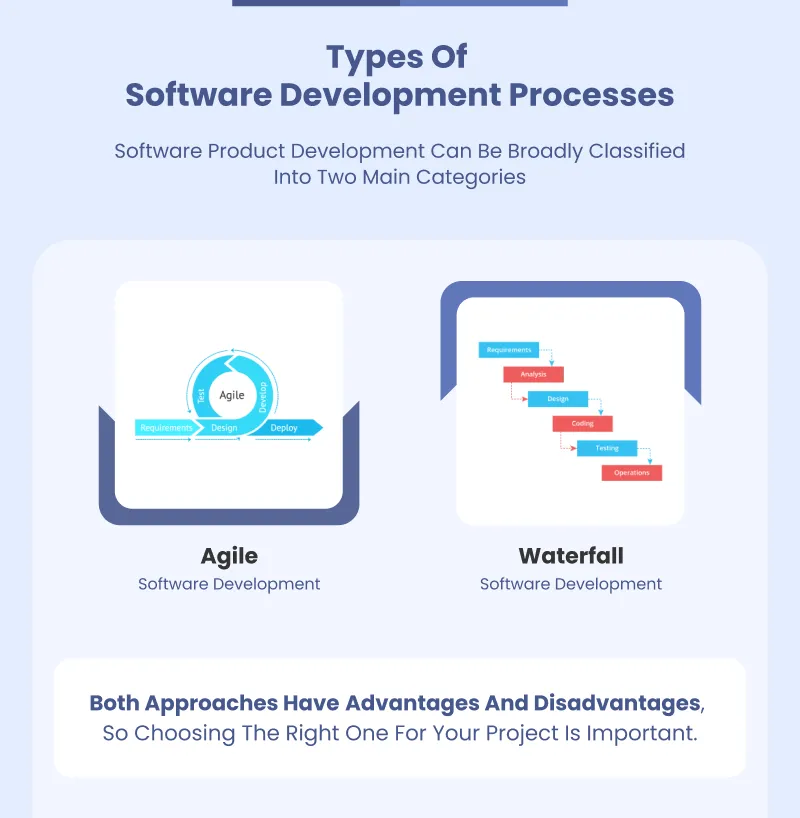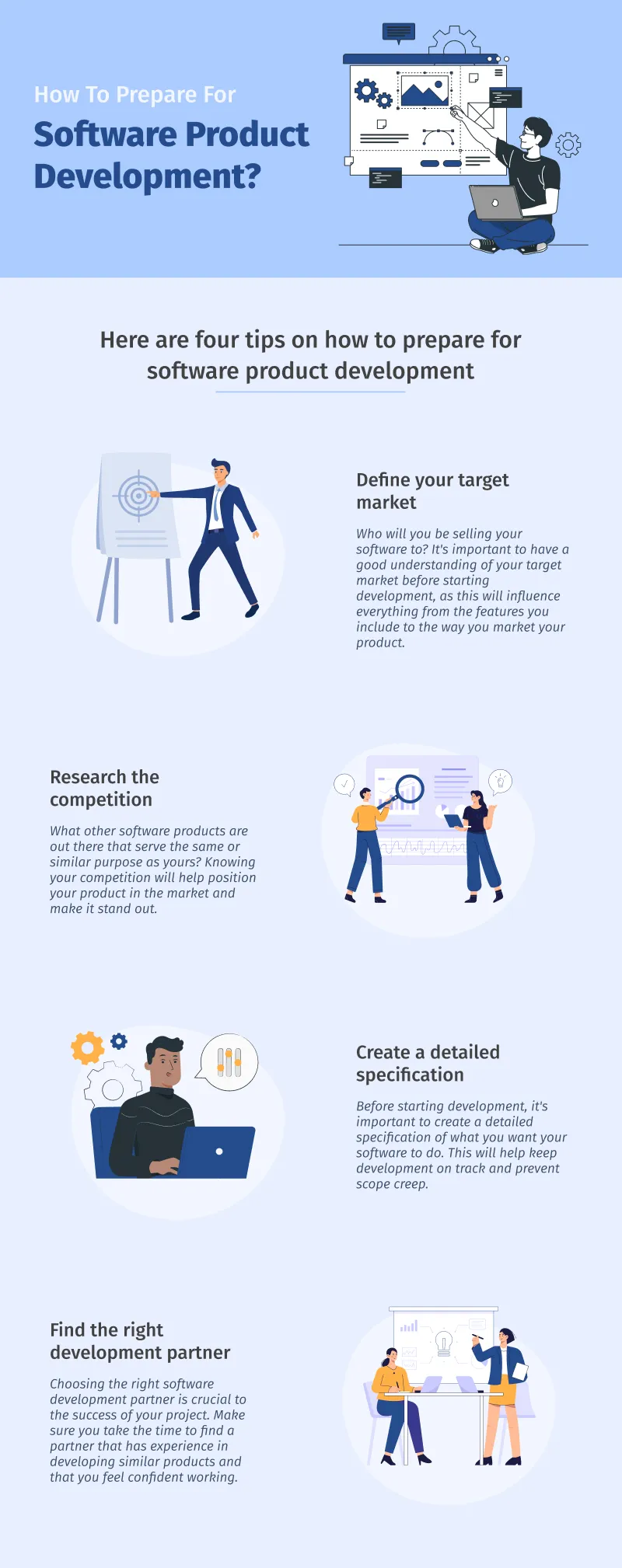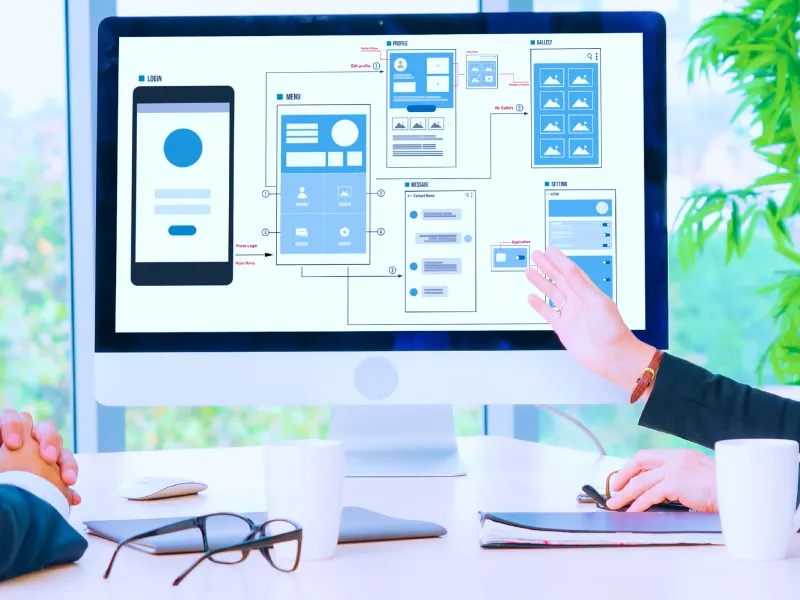Creating a product-market fit software is one of the essential tasks of modern businesses. They need to understand the complete software development life cycle to accomplish this, enabling them to develop the right software product in this competitive era.
This blog will seek software development processes, types, stages of software product development life cycle, and their importance for new businesses.
Before starting our journey, have a look at the incredible stats of the software product development market to date:
- As per The Business Research Company, the software products market is expected to grow to $2,040.37 billion in 2026 at a CAGR of 11.8%.
- North America is expected to remain the largest market for software product development, with a share of 38.8% in 2022.
- The Asia-Pacific software product development market is projected to grow at the highest CAGR of 12.9% during the forecast period.
- The small and medium enterprises (SMEs) segment is expected to be the fastest-growing end-user segment of the software product development market, with a CAGR of 13.4% during the forecast period.
Software Product Development: An Overview
Software Product Development is designing, creating, testing, and maintaining software products. It includes the software engineering process of developing software programs and the business aspects of managing software projects.
Moreover, it is a complex process that involves many stages, from initial conception to final delivery. The development process must consider the software product’s various elements, including its functionality, usability, performance, and security.
In addition, the software product must be compatible with the hardware it will run on and meet all applicable standards.
It typically begins with a requirements-gathering phase, in which the end user’s needs are identified. Once the requirements are understood, the software engineers can begin designing the software. The software is then coded or programmed and undergoes extensive testing before it is finally released to the end user.
After we release the software product, the software development team may continue to work on it, adding new features or fixing any discovered bugs. Software products are often updated regularly, even after they have been released to the public.
Software product development might be challenging but can be advantageous. A well-designed and well-executed software product can make a difference in people’s lives. It can help them be more productive, efficient, and organized. A software product can improve communication and collaboration among team members.
When done right, software product development can be a rewarding experience for all involved.
Also Read: 7 Stages In Software Product Development – A Successful Project Onboarding
Types of Software Development Processes
Software product development can be broadly classified into two main categories:
- Agile Software Development
- Waterfall Software Development
Both approaches have advantages and disadvantages, so choosing the right one for your project is important.
Agile Software Development is an iterative and incremental approach to software product development. It focuses on delivering software in short cycles, known as sprints, and frequently evolving the software based on customer feedback. This flexibility makes agile software development well-suited for projects with rapidly changing requirements.
Waterfall Software Development is a more traditional approach that takes a linear and sequential approach to software product development. Each project phase must be completed in this approach before moving on to the next phase. It can make waterfall software development more predictable and easier to manage but less flexible when compared to agile software development.
Which approach is right for your project will depend on several factors, including the nature of the project, the team’s experience, and the customer’s preferences. Ultimately, the best approach is the one that will help you deliver a high-quality software product on time and within budget.
Why Do Businesses Require Software Product Development?
A well-designed software product can give you an edge over competitors in today’s competitive market. A custom software solution can help you better serve your customers and meet their needs more effectively.
Since your business is unique, software product development can help you capitalize on your distinguishing qualities and give you a competitive edge. By streamlining processes and automating tasks, software product development can save your business time and money.
The software development process involves creating custom software solutions specific to your business’s needs. This process can help you overcome many common business challenges, such as:
- Inefficiencies caused by using off-the-shelf software that doesn’t meet all of your needs
- A lack of scalability or flexibility as your business grows
- Lack of customer engagement due to a poor user experience
Accelerate your business growth with our top-notch software product development services
There are many benefits to pursuing Software Product Development for your Business:
- It allows you to get what you need from your software solution. There’s no more trying to make a square peg fit into a round hole – with custom software; you can have a solution designed specifically for your business.
- Software product development can save you time and money in the long run. When you have a software solution tailored to your specific needs, you are less likely to encounter problems down the road. This can save you both time and money in troubleshooting and maintenance.
- Software product development allows you to have a competitive edge. With a custom software solution that meets your unique business needs, you can give yourself a leg up on the competition.
When Your Business Needs Software Product Development?
No matter how small or large your business may be, you should be prepared to adapt to the needs of your customers, both current and future. To do that, you need to stay on top of the market, keep an eye on the competition, and react accordingly by creating new products and services that fill existing gaps in the market or provide a competitive advantage over other businesses in your industry.
One way is through software product development – creating custom-made software solutions that meet your customers’ needs. But how can you know when to bring in outside help and outsource this process? Learn here:
When There Is A Need For Automation
It’s a fact: the more you automate, your business becomes more efficient. That’s because computers can process information much faster than humans, which saves time and money.
In today’s global economy, where companies compete for 24/7 on every continent, it just makes sense to automate as many tasks as possible to maximize production without sacrificing quality or efficiency.
If your company could benefit from a software product development lifecycle, it might be time for an upgrade!
If The Current Software Cannot Be Customized To Meet The Business’s Specific Needs
Software development can be expensive, so it’s important to know when your business is ready. Before you invest in a software developer, ask yourself if the current software cannot be customized to meet the business’s specific needs. If this applies, then you may need a Software Development Company. You will want to find one with experience with your industry and business type.
For example, a consulting firm could not provide the same services as a retail chain. Make sure you are up-to-date on new technological trends before engaging in contracts with developers. Some of these trends include SaaS (software as a service) providers like Salesforce or Box, platforms such as Magento or Shopify, and technologies such as HTML5 and mobile applications.
When Your Company Experiences Low Efficiency & Miscommunication-related Issues
Software product development can help solve efficiency and miscommunication-related issues. Once your company starts experiencing low efficiency or miscommunication-related issues, you may be ready for software product development. One way that it can help fix these problems is by providing employees with a centralized system where they can go to get up-to-date information.
In addition, new tools such as Microsoft Flow provide an automated way of handling repetitive tasks.
When Your Supply Chain Has Many Bottlenecks
If your supply chain has many bottlenecks, consider looking into software product development. With the use of software products and software development services, these dilemmas can be solved, and your business will run smoothly.
The following are some signs that your company might need to create a software product:
- If there are too many points in the process, delays or mistakes can happen.
- If there are significant quality issues with processes or output.
- If production capacity is constrained by equipment or personnel issues (such as skills shortages).
- If frequent changes in technology make it difficult to keep up.
Partner with ValueCoders for expert software development outsourcing and access diverse skill sets through our development team.
When your Business is Growing
As your business grows, you may need software product development services to keep up with the demands of your company. For example, as you become more successful, you might find that your previous tools no longer work well enough or have enough features to handle your needs.
You may also need software product development because of the changing market and new technology. Whatever the reason for needing software product development services, you want to be sure that it will be worth it before investing in them.
When Your Customer Base Increases
One of the first things you’ll notice when you’re ready to begin software product development is that your customer base has increased. This might be because your business has grown or because you’ve been able to reach a new audience. An increase in customers can signify that it’s time to start looking into the next phase of your business, which includes developing a software product.
Whether building an app, developing a website, or releasing another physical product, the decision will ultimately depend on your goals. Once you know what type of software product will best suit your needs and vision for the software application development company long term, hiring software developers will help bring your idea to life.
When you Business is Expanding to Other Locations
When expanding your company to other locations, it’s time to invest in software product development. Utilizing a product that is already established and has already been tested will make your company more efficient. Plus, you’ll save a lot of money because you won’t need to spend money on developing software from scratch. An existing product can also be very beneficial when expanding internationally.
Also Read: 20+ SaaS Product Ideas To Empower Your Business-Valuation
How To Prepare For Software Product Development?
By preparing for your software product development project, you can ensure that everything goes smoothly and that your final product is of the highest quality. There are a few things you should keep in mind to ensure success. Here are four tips on how to prepare for software product development:
Define your Target Market
Who will you be selling your software to? It’s essential to have a good understanding of your target market before starting development, as this will influence everything from the features you include to the way you market your product.
Research the Competition
What other software products are out there that serve the same or similar purpose as yours? Knowing your competition will help position your product in the market and make it stand out.
Create a Detailed Specification
Before starting development, it’s important to create a detailed specification of what you want your software to do. This will help keep development on track and prevent scope creep.
Find the Right Development Partner
Choosing the right software development partner is crucial to the success of your project. Make sure you take the time to find a partner that has experience in developing similar products and that you feel confident working.
Essential Stages Of Software Product Development
Software product development is taking an idea or concept and turning it into a tangible, usable piece of software for consumers to do whatever they wish.
This process, no matter how similar it may seem from project to project, never follows the same path or schedule twice, meaning that each software product goes through its unique stages and variations of each stage.
These stages are as follows:
Ideation
Ideation is the first stage of software product development. It involves brainstorming and coming up with as many creative ideas as possible. This stage aims to generate enough viable ideas that may eventually lead to a successful product. If you don’t have enough ideas, ideation can be conducted by a group of people in a brainstorming session. Once an idea emerges from a session, it should be documented so it’s not forgotten later.
The next step is to decide which ideas are most feasible or desirable for development and try to build them into a prototype or mock-up. You should also try to assign them one or more key features that will make them unique and stand out from other products on the market.
Planning
Planning is the second stage of software product development. You are detail mapping out the entire project and its scope during this stage. You will be defining goals for the project, creating a timeline of milestones, budgeting, and defining roles and responsibilities. You will also identify what your team needs to do throughout the project to complete it successfully.
For example, at this stage, you might hire developers or designers if you don’t have those skills on your current team. If your business doesn’t offer these services, you will start researching companies that can provide these services. You would then reach out to them and send them an RFP (request for proposal) outlining exactly what they need to provide. If they accept your proposal, you can move on to the next stage of developing your product.
Design
The user interface is created and visualized in the design stage. Sketches and wireframes are drawn to illustrate what the interface should look like. Research is conducted to understand better how users will interact with the product. This stage can be divided into low-fidelity wireframes, high-fidelity wireframes, and interactive prototypes.
Low-fidelity wireframes are sketches of what an app or website might look like without pixel precision. Low-fidelity wireframes explore various layout options to determine which best suits a user’s needs. They don’t include much detail about color, fonts, or graphics because they’re not intended to be used as blueprints for development.
High-fidelity wireframes take it one step further by including more detail about color, fonts, and graphics, but no programming has been included yet.
Interactive prototypes take it even further by including animation and real programming (though it may not always have finished coding). They give users a chance to see what the product will look like when they use it while still giving developers room to work on new features later in development.
Implementation
Implementation is the process of developing the product and tying together all of the pieces. The first step in this stage is to plan how you want to execute your development. This includes choosing which tools to use, making a timeline, and mapping out where you are in project budgeting.
Next, create a list of activities that need to be completed to get your product off the ground. Your list should include what needs to be done, who will do it, when they will do it, and how much time they will take. Finally, prioritize each task based on its importance and urgency, so you know which tasks need to be addressed first.
Testing
In the fifth stage of software product development, the product is checked for bugs and errors in software. This stage can be performed by manual or automated testing. Manual testing could involve using paper documents and walking through steps in the software’s design to ensure it does what it is supposed to do.
Automated testing could involve many methods, such as rerunning loops over and over until certain conditions are met, running a script with a tool such as Selenium to check every web page loaded on a website, and writing scripts that attempt valid user input in an application.
Deployment
At this point, the software is complete, and you’re ready to deploy it. There are many things you’ll need to do before deploying your software, such as:
- Install the software on a server.
- Create a new database or configure an existing one.
- Configure the deployment using administration tools like FTP or SFTP.
- Configure any third-party services (e.g., Google Analytics) that you want to integrate with your application.
- Configure any email notifications for alerts and outbound marketing campaigns.
- Export backup information and other configuration data.
- Run performance tests to make sure everything is running smoothly.
- Get the latest security updates from the developer’s site or another trusted source.
- Test in different browsers on different operating systems (Windows, Mac OS X). Test the system when it has limited bandwidth available. Test it when there is no network connectivity at all. Test it when only one browser is installed on the system where you’ve deployed your application (i.e., ensure your site still functions even if a user doesn’t have Chrome installed).
Note: Deployment should be well planned and orderly; otherwise, errors will happen during deployment, which could cause downtime of critical resources.
Maintenance
Once your app is fully released, the development process isn’t over yet. Ongoing maintenance and updates are necessary to keep your app running smoothly and up-to-date with current trends. Here are some things to consider after completing stage six of the software product development process:
1) Analyze data for bugs and glitches reported by users during the testing phases.
2) Create a schedule for routine updates, patches, and fixes.
3) Update coding language to comply with new programming standards.
4) Address any security concerns as soon as possible.
5) Monitor feedback from testers to ensure you’re meeting user expectations and needs.
6) Consider implementing new features and updating existing ones based on customer requests.
7) If changes require an update to program code or additional programmer work, re-evaluate their prioritization based on the cost they will incur in terms of time and resources.
8) Continue monitoring technology trends related to your product so that you can continue providing relevant content or services to your customers.
9) Provide customer service support by responding promptly and courteously when customers contact you with questions about their use of the product or services provided through it.
Accelerate your business growth with our top-notch software product development services
How To Have A Successful Business With Software Product Development?
Having a software development team in-house can save your business time and money. By having a software development team, you can create a product tailored to your specific needs, and you can get it done faster and cheaper than if you outsourced the work.
Below are some tips on how to have a successful business with software product development:
Define Your Goals
The first step to having a successful software product development team is to define your goals. What do you want to achieve with your software? What problem are you trying to solve? Once you know what you want to accomplish, you can set clear objectives for your team and hold them accountable.
Communicate Clearly
Effective communication is essential for any software development team. Make sure that everyone on your team knows the project’s goals and understands their role in achieving them. Clear communication will help your team work together more efficiently and avoid misunderstandings that can lead to errors.
Establish A Process
A software development process helps your team members understand what needs to be done and when it needs to be done. By establishing a clear process, you can avoid duplication of effort and wasted time. Many software development processes are available, so find one that works best for your team and stick to it.
Use The Right Tools
Having the right tools is essential for any software development team. The right tools will help your team work more efficiently and avoid errors. Many software development tools are available, so choose the ones that best fit your team’s needs.
Test your Software
Before you release your software to the public, it’s important to test it thoroughly. Testing will help you find and fix any errors in your software. Make sure to test your software on all platforms it will use.
Train Your Users
If you want your users to be successful with your software, you need to train them. Training will help them understand how to use your software and how to get the most out of it. Make sure to provide adequate documentation and support for your users.
By following these tips, you can have a healthier and better business with software product development. Having a software development team can save you time and money and help you create a product tailored to your specific needs. With the right team in place, you can accomplish anything you set out to do.
Partner with ValueCoders for expert software development outsourcing and access diverse skill sets through our development team.
How To Select The Right Partners For Software Product Development?
The software product development process is a long and complicated one, involving many different partners along the way. From designers to developers to marketers, it takes a team of experts to bring a product to market. But how do you know which partners are right for your project? And how can you ensure that everyone is on the same page, working towards the same goal?
Here we will explore selecting the right partners for software product development.
Conduct A Background Check On The Company
When selecting a software development partner, conducting a background check on the company is important. This will help you ensure that the Software App Development Company is reputable and has the experience and expertise necessary to produce a high-quality product.
To conduct a background check on a software development company, start by searching for the company online. Review the company’s website and look for customer testimonials or case studies. You can also search for the company in Google News to see if there are any recent news stories about them.
Next, check out independent review sites like Clutch or G2 Crowd to see what real customers say about the company. Finally, contact the company directly and ask them any questions about their experience or process. By taking these steps, you can be confident that you’re selecting a reputable software development partner.
Check a Company’s Ability
When you are looking to partner with a software development company, it is important to check their ability. This includes looking at their portfolio, case studies, and reviews. Checking a company’s ability will give you an idea of the quality of work they can provide and whether they are a good fit for your project.
Knowledge Of Different Methodologies
They have the knowledge and experience with different methodologies. This is important because it will ensure that they are able to adapt to your specific needs and requirements. Furthermore, it will also allow them to provide you with the best possible solution for your project.
There are a variety of different software development methodologies that partners can use, so it is important to make sure that they are familiar with the ones that you are interested in. Some popular options include Agile, Scrum, Lean, and Kanban.
It is also a good idea to ask about their experience with other tools and technologies you plan to use for your project. This way, you can be sure they can properly support your development process.
Ability To Support Throughout The Cycle
The ideal partner will provide support during the entire development process, from initial planning and requirements gathering to final testing and deployment. They should also be able to provide ongoing support and maintenance after the product has been launched.
When evaluating potential partners, ask them about their support model and what level of support they can provide throughout the development cycle. Find out if they have a dedicated support team or if they outsource this function. Also, inquire about their post-launch support offering and whether they offer bug fixes, security updates, and new features as part of this service.
Ability to Understand Your Business
The right partner for software product development should clearly understand your business. They should know your company’s goals, objectives, and values. Furthermore, they should be able to understand your target market and audience. With this knowledge, they can help you develop a software product that meets your customers’ needs and helps you achieve your business goals.
Capable Testers
As your software product development partner, one of our primary objectives is to help you achieve high quality for your end product. Achieving this goal requires the involvement of highly skilled and capable testers who understand the nuances of testing software products.
Conclusion
I hope you’ve found this guide helpful and given you a good overview of the software product development life cycle. As we mentioned earlier, different businesses will have different needs and requirements for their software products, so it’s important to tailor the process accordingly.
If you’re seeking more specific advice or want help planning your software product development project, feel free to contact us. At ValueCoders, we have a proficient team of 650+ in-house software developers who can serve you 24*7. Outsource our software development services and leverage various business benefits for your next project.










